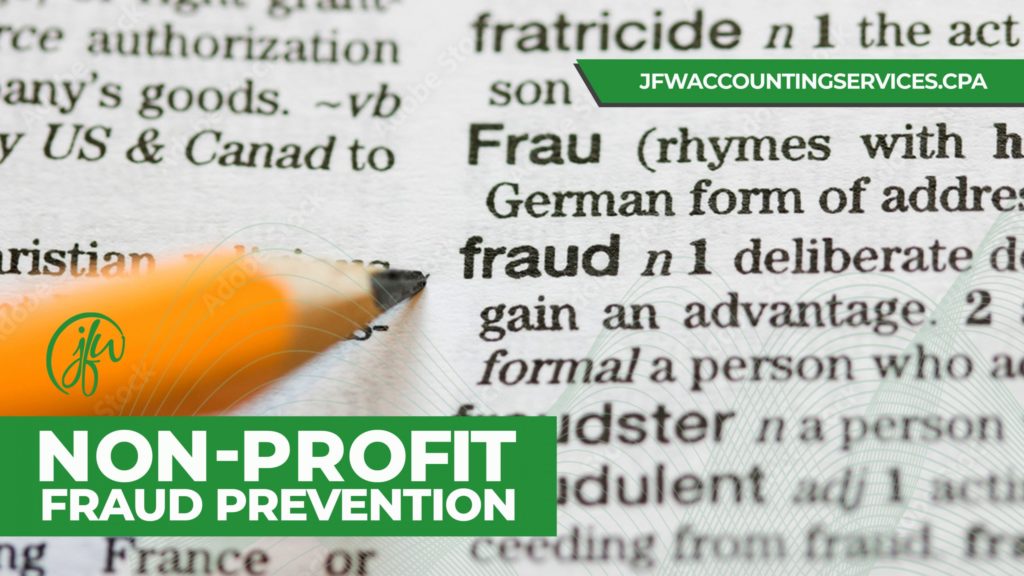Running a nonprofit organization takes a lot of hard work. Nonprofits operate using as few resources as possible, which allows the organization to contribute more to its mission. However, fewer resources also make them susceptible to fraud. To continue fulfilling their mission, nonprofits must learn to protect themselves from fraud.
The Association of Certified Fraud Examiners (ACFE) publishes a report every two years on workplace fraud. The 2020 report showed that there were 191 cases of nonprofit fraud. The study reported that the median loss was $75,000. The biggest contributor to fraud in nonprofits is the lack of internal controls. It is often because they have fewer resources and more trusting management.
There are ways to reduce the risk of fraud in your organization. Increasing internal controls is one way. Continue reading to learn some preventive measures that you can put in place to protect your nonprofit.
Possible Preventive Measures
Many leaders are concerned about the cost of increasing internal controls. While there is cost associated with implementing preventive measures, there are also some inexpensive actions you can take.
Require Double Signatures Or Authorizations And Backup Documentation
Check and payment tampering account for 14% of nonprofit fraud cases. Dual authorizations and proper backup are two ways to prevent this type of fraud. Require that all payments being made from the organization have the proper backup. Proper payment documentation should include a copy of the invoice or approval for the payment request. Requiring two manager signatures or transaction approvals will also help prevent check fraud.
Segregate Financial Duties
Segregation of duties is an important part of internal controls. It can be very challenging in smaller organizations because of the lack of staff. However difficult, financial duties should be performed by separate staff members or consultants whenever possible. One example is banking. The person that cuts checks, or processes payments, should not be the same person that prepares and reviews bank reconciliations.
Do Fixed-Asset Inventories
Performing a physical inventory on fixed assets helps to prevent loss. Fixed asset inventories should be done on an annual basis. Identifying assets that are owned by the organization and comparing that they are correctly reflected on the balance sheet will prevent fraud. Fixed assets could include computers, vehicles, buildings, software, and other long-term assets.
Set Up Automated Controls
Automated controls can help prevent fraud without increasing the size of your staff. Automation programmed into your software is one way to detect fraudulent activity. Often simple accounting software allows for some automated controls to be turned on. The banking portal used to process payments may also offer an automated control option.
Establish Audits And Board-Level Oversight
External audits can be expensive, although they are worth the cost if you suspect fraudulent activity. Internal audits are recommended on a regular basis though and should analyze financial reports, ensuring the physical support is intact. Management or a board member should be involved in this high-level review, as it should not be performed by those that prepare the reports.
Encourage Whistleblowers
According to the ACFE report, 40% of fraud cases in nonprofit organizations are detected by tips or complaints. Having a well-written and communicated whistleblower policy is an important step in fraud prevention. Staff members should know how they can report unethical activity and that they will be protected after doing so.
Have A Compliance Program
A formal compliance plan is important to set up in a nonprofit organization. The plan allows the company to be transparent about policies they have in place regarding unethical behavior, whistleblowers, document retention, and conflicts of interest. A structured compliance program not only deters fraud but is a useful tool in defending the organization against allegations.
Communicate With Donors
For a nonprofit to be successful, it must communicate with donors. Sharing compliance plans and annual financial reports are expected by many contributors. Open communication with donors also helps in reviewing donor activity for fraud. The financial records should be compared to an external list of donors regularly as well as the donor restrictions confirmed.
Get Insurance
Make sure that your company insurance policies protect your organization in the event of fraud. Typical business umbrella policies do not always cover theft. But there are policies that will protect your organization. Crime insurance protects the organization from theft, fraud, and embezzlement. Other policies to consider include the directors and officers liability (D&O) which will protect board members from personal liability in the event of fraud.
Final Thoughts
Unfortunately, nonprofit organizations are not exempt from being victims of fraud. Implementing some of the controls above can help protect your company from risk. It is important to get and stay educated about fraud risks. Using resources offered by the AICPA is one way to stay current on preventive measures.
Reach out to JFW Accounting Services today to see how we can help your organization minimize its risk.

Jo-Anne Williams Barnes, is a Certified Public Accountant (CPA) and Chartered Global Management Accountant (CGMA) holding a Master’s of Science in Accounting (MSA) and a Master’s in Business Administration (MBA). Additionally, she holds a Bachelor of Science (BS) in Accounting from the University of Baltimore and is a seasoned accounting professional with several years of experience in the field of managing financial records for non-profits, small, medium, and large businesses. Jo-Anne is a certified Sage Intacct Accounting and Implementation Specialist, a certified QuickBooks ProAdvisor, an AICPA Not-for-Profit Certificate II holder, and Standard for Excellence Licensed Consultant. Additionally, Jo-Anne is a member of American Institute of Certified Public Accountant (AICPA), Maryland Association of Certified Public Accountants (MACPA), and Greater Washington Society of Certified Public Accountants (GWSCPA) where she continues to keep abreast on the latest industry trends and changes.

